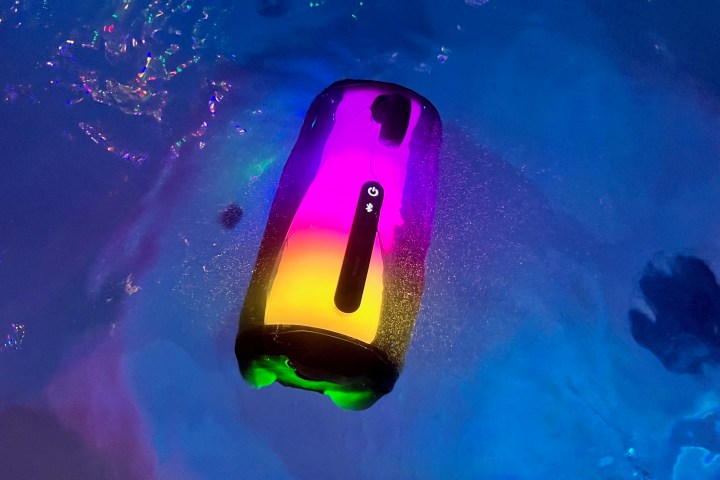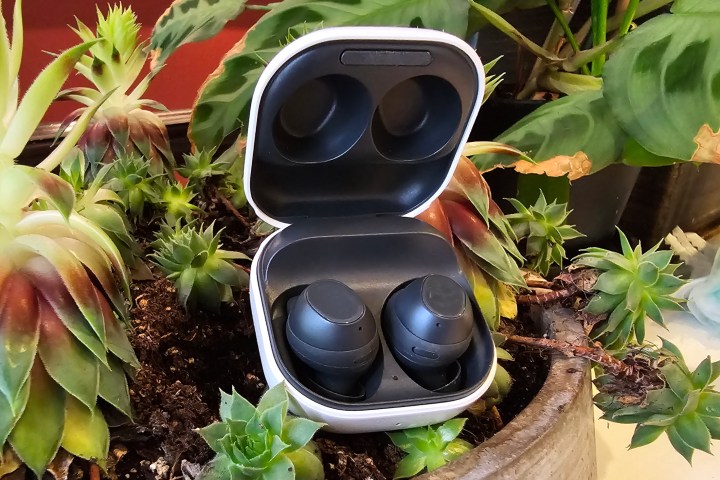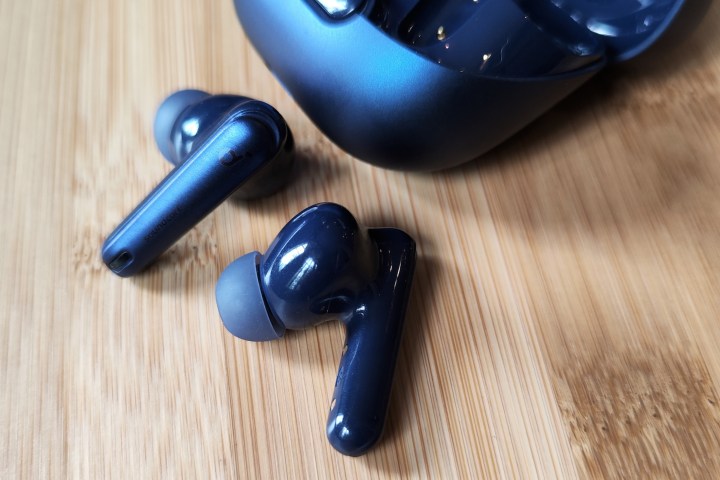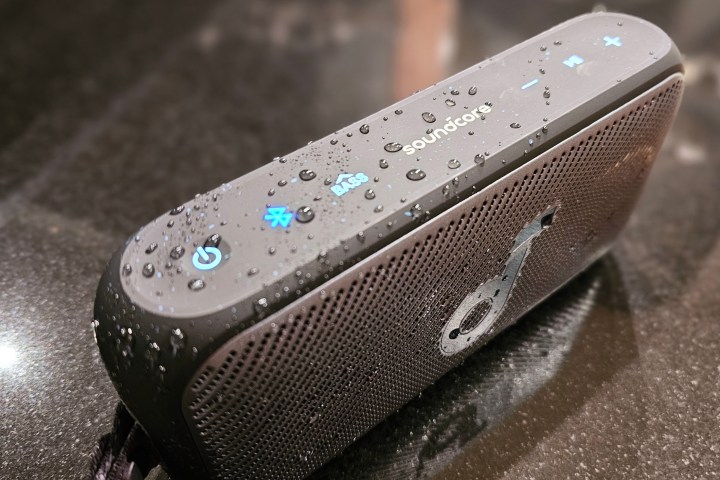If you’re shopping for a new set of primo earbuds, a Bluetooth speaker, or a range of other devices, it’s likely that resistance to water, sweat, and dust is a factor you’re considering. Maybe you want to work out with your earbuds and are worried about sweat ruining them, or perhaps you’re having a beach day and want to make sure your portable speaker can handle some sand and maybe even a little submersion.
During your search, you’ve probably encountered a cryptic code that looks like this: IPXY, where the X and/or Y are sometimes replaced by numbers, e.g. IPX5. This is commonly referred to as an IP rating. Manufacturers will usually toss that cipher into their descriptions at some point as a measurement of how water- and dust-resistant their products are.
But what exactly do these numbers mean, and how do they apply to everyday use? If you’re on the lookout for a new pair of headphones for swimming or watersports, then this absolutely applies to you. Luckily, we’re here to help you crack the code with a step-by-step explanation of this oft-used, but seldom explained technical rating for water and dust resistance.
What are IP and IPX?

IP, IPX, or IPXY are all references to a standardized rating for how well a product can prevent solids and liquids from entering, and thus possibly causing damage to, your electronics. Officially, IP stands for “International Protection” marking because the standard was developed and is maintained by the International Electrotechnical Commission. But it’s more commonly referred to as Ingress Protection. The two numbers that follow the letters IP indicate what kind of protection you can expect.
The X is the solids/dust protection level, from zero to six, where zero means no protection whatsoever and six means it’s dust-tight: no dust can enter at all, even after exposure for up to eight hours. Because very few consumer devices are designed to keep out dust (presumably, it’s just not something people usually need), this part of the IP rating is often left out. That’s why we most often see an X after IP, e.g. IPX5 — it means there’s no rating for the solids ingress portion.
The Y is the liquids protection level from zero to eight, where zero means no protection whatsoever and eight means it can withstand being immersed in water, usually up to a depth of 3 meters, for up to at least 30 minutes. Technically, there is a ninth level of liquid protection, but it isn’t used for consumer electronics products. There is no “X” level for water protection, so you’ll never see an IP code expressed as IP2X, for example — it would be IP20 if no water protection is offered.
Don’t worry, we have some charts further down that lay out all this information clearly if you want to look up specific protection.
Which resistance is right for me?
If you’ve already guessed that an IP68 rating is the best you can get for protection from both dust and liquids, congrats, you just aced the first quiz! But in between IP00 and IP68, there’s a lot of variety, so let’s take a look at some specific examples.
IPX2

With IPX2, your device can withstand a small amount of dripping water without being damaged. Since most of us don’t place our gadgets under leaky faucets very often, in practice, this translates into “moderately sweatproof.” The Samsung Galaxy Buds FE earbuds, for example, are rated for IPX2, meaning that they’re safe enough to handle the sweat of your workout or run, and maybe some light rain. But do not try to wash these earbuds under running water — it’s better to wipe them with a damp cloth.
IPX4

IPX4 offers decent protection against splashing water. Keep in mind, this isn’t waterproofing — you shouldn’t dunk IPX4 products in water — but it is an excellent degree of protection for ultra-active workouts or even long marathons in inclement weather. Most earbuds, whether wireless or wired, aimed at earbuds are IPX4 rated and should have no problem coping with regular use during these activities. Anker’s excellent Soundcore Liberty 4 NC earbuds are IPX4 rated. Again, don’t submerge these products.
IPX6
IPX6 concerns itself with protection from powerful jets of water, which means you can probably take them in the shower with no serious side effects, but don’t make a habit of it. Do not actually put them under the water — don’t go swimming or expect them to necessarily survive an accidental encounter with a toilet bowl.
IPX7/8

If you’re a complete klutz and have been known to drop your phone, camera, or watch into bodies of water both indoors and out, don’t settle for anything less than IPX7. This will protect your gadget from accidental kerplunks in one meter of water for up to 30 minutes, while IPX8 allows for the same time period of protection in even deeper water (with the exact depth to be specified by the manufacturer).
Bluetooth speakers designed for the water will be rated at least IPX7, such as the Soundcore Motion 300, which you can safely take out into the pool without worrying. Many of our top picks for e-book readers also have X7 or X8 ratings. The iPhone 15 series and the Samsung Galaxy S24 are both IP68 rated, which means no dust will get in, and water will have a hard time, too. These products can be safely rinsed off under gentle running water, but always follow the manufacturer’s instructions.
Water resistance by the numbers
Want to get technical? Here’s what the IP water resistance numbers mean, 1 through 9. You’ll note that the descriptions are very lab-friendly in that they make it easy to test these resistances in the laboratory. Real-world results aren’t quite as certain, but these are still useful guidelines.
| Level | Protection against |
| X | No data available |
| 0 | None |
| 1 | Protected against vertically falling water drops |
| 2 | Protected against vertically falling water drops when the enclosure is tilted up to 15 degrees |
| 3 | Protected against “spraying” water at an angle up to 60 degrees on either side |
| 4 | Protected against “splashing” water from any direction |
| 5 | Protected against “water jets” from any direction |
| 6 | Protected against powerful “water jets” |
| 7 | Protected against the effects of “temporary immersion” in water |
| 8 | Protected against the effects of “continuous immersion” in water |
| 9 | Protected against “high pressure and temperature” water jets |
Water submersion by the numbers
For true underwater use, where you would take a product snorkeling or scuba diving, you should be looking for a diver’s rating based on the ISO 6425 standard (not the IP standard) for divers’ watches. These products are individually tested and must perform at depths that are 25% deeper than the number claimed on the dial. Watches with these ratings are typically guaranteed by the manufacturer to survive repeated use at these depths for prolonged periods, as well as being able to handle the changes in pressure that accompany the act of descending to and ascending from those depths.
| Water resistance rating ISO 6425 | Suitability | Remarks |
| Water Resistant 3 atm or 30 meters | Suitable for everyday use. Splash/rain-resistant. | Not suitable for showering, bathing, swimming, snorkeling, water-related work, fishing, and diving. |
| Water Resistant 5 atm or 50 meters | Suitable for everyday use, showering, bathing, shallow-water swimming, snorkeling, water-related work, fishing. Splash/rain-resistant. | Not suitable for diving. |
| Water Resistant 10 atm or 100 meters | Suitable for recreational surfing, swimming, snorkeling, sailing, and water sports. | Not suitable for diving. |
| Water Resistant 20 atm or 200 meteres | Suitable for professional marine activity, serious surface water sports, and skin diving. | Suitable for skin diving. |
| Diver’s 100 meters | Minimum ISO standard (ISO 6425) for scuba diving at depths not suitable for saturation diving. | Diver’s 100-meter and 150-meter watches are generally old(er) watches. |
| Diver’s 200 meters or 300 meters | Suitable for scuba diving at depths not suitable for saturation diving. | Typical ratings for contemporary diver’s watches. |
| Diver’s 300-plus meters for mixed-gas diving | Suitable for saturation diving (helium-enriched environment). | Watches designed for mixed-gas diving will have the DIVER’S WATCH xxx M FOR MIXED-GAS DIVING additional marking to point this out. |
Dust resistance by the numbers
We haven’t discussed dust resistance much yet: It’s a simpler standard that’s easier to understand and most useful for those taking their devices out into nature or on active job sites where dust contamination is a possibility. If your device has a numeral in the third IP place, here’s what it means.
| Level | Protection against |
| X | No data available |
| 0 | None |
| 1 | Protected against solid foreign objects of 50mm and greater |
| 2 | Protected against solid foreign objects of 12.5mm and greater |
| 3 | Protected against solid foreign objects of 2.5mm and greater |
| 4 | Protected against solid foreign objects of 1.0mm and greater |
| 5 | Dust-protected |
| 6 | Dust-tight |
The difference between dust-protected and dust-tight may seem vague, but generally, dust-tight is a much more rigorous rating involving dust, airflow, prolonged exposure, and vacuum seals.
FAQ on waterproofing
If a product is IPX8, does that mean it’s also good for IPX1-7 too?
Not necessarily. Each level of IPX protection can act as its own standard, which is important when separating the differences between protection against jets of water from different angles versus ingression and immersion of water. Sometimes you will run across headphones or earbuds that say something like “IPX5/7,” which means they offer both the jet-proof quality of X5 and the immersion protection of X7. However, devices may simply provide the highest IP number to avoid creating confusion.
Does water or dust damage void my warranty for IP-rated products?
Manufacturers may add their own specific descriptions or limitations that you can look at for more information. That includes potential caveats as well. For example, Apple specifically states that liquid damage is not covered under warranty and that resistance can decrease over time through wear and tear — as well as recommends users avoid taking an iPhone surfing, skiing, in the sauna, etc.
Does IPX8 or X9 mean it’s fully waterproof?
No. The term “waterproof” is more of an ideal than an actual rating. A genuinely waterproof product would be one that never lets water in under any circumstances. Because that’s rarely the case, we tend to talk more about water resistance. IPX7/8 are intended as ratings for the survival of a gadget after a certain kind of short-term or accidental immersion in water — they are not an indicator that your product is meant to be used continuously under water.
In fact, even when you see products (usually watches) that have a water resistance mark (WR), e.g. 30M, that’s still no guarantee that it will survive in the water. Unless otherwise specified, these products aren’t individually tested, and only one brand-new example product is needed to pass a very basic water immersion test in order for every watch of that design to bear the WR mark.
That being said, some products are clearly designed for frequent submersion in water, like diving watches, outdoor Bluetooth speakers, and headphones for swimmers. Water may still damage these devices as they suffer from wear and tear, but they are made with serious water use in mind.
What if my product doesn’t have an IP rating?
You’ve probably already noticed that plenty of devices can survive an encounter with water or dust, even if they don’t come with an IP rating from the manufacturer. There’s a good chance you’ve been for a few sweaty runs with your non-rated Apple AirPods, wiped them off, and experienced no problems at all. Sometimes that’s due to good design, and other times, it’s luck. An IP rating is your only true indication that a manufacturer has designed the product to perform under those conditions. But keep in mind — it’s not a guarantee. Always check your product warranty for what is and is not covered.
What if there’s an additional letter on the IP rating?
In some cases, an additional letter is used to indicate something else important about the device. This is not common on audio devices, which generally keep things simple. But if you see, for example, a “W” on the IP rating, that means it’s rated for weather conditions. An “F” means the product has oil resistance, an “M” means the device was tested moving in water instead of stationary, and so on. These extra ratings are often found on commercial and factory-oriented gear.
What if there’s an additional number on the IP rating?
This doesn’t happen much anymore, although you may encounter it on older devices. An extra number signifies mechanical impact resistance, such as from dropping the device on the ground. It may go from 1 to 10, with 10 being the highest resistance and the highest drop point. This was moved onto its own IK rating some time ago, and many brands use military drop test ratings instead.



